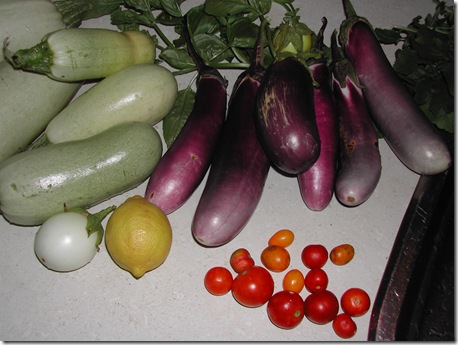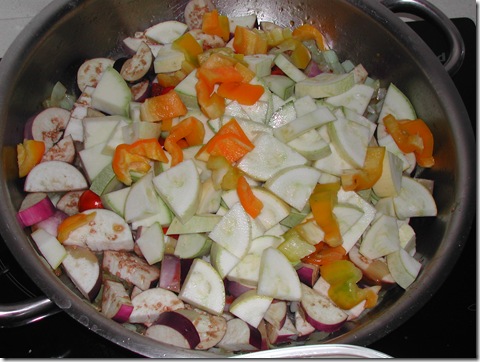Eggplants belong to the same family of vegetables (SOLANACEAE) as tomatoes, chillies, capsicums and potatoes. In France they are known as ‘aubergines’. They range from the large popular Australian deep purple ‘Black Beauty’ to pea-sized yellow ones from Thailand. Originating in India and Burma, they first arrived in China by the 4th century, and were introduced to Europe by the Arabs in the 7th century [from ‘The Seed Savers’ Handbook’ by Michel and Jude Fanton]
This year, I grew the ‘long white-streaked eggplants’, and some pure white egg-sized eggplants that remind one where the name ‘egg-plant’ actually came from!
Both are seen in the photo below (with a lemon in between), along with cherry tomatoes, basil and Italian grey-ribbed zucchinis. Note the spherical (bitter) yellow eggplant lurking at the top of the purple ones; this came off the same bush as the white ones.
These vegetables can be chopped into cubes and combined with salt, onion fried in olive oil, garlic, capsicums, oregano and other herbs to make a warm slowly-cooked side-dish of vegetables called ‘ratatouille’ that’s both tasty and nutritious.
Eggplant seeds are usually saved by cutting off the bottom seed-carrying part of large well-shaped early-maturing eggplants and putting them through a blender at slow speed with water before pouring out the mixture and selecting out the seeds for sieving, drying and storing.
Eggplants, and more commonly capsicums, are increasingly able to survive our warmer winters on the Adelaide Plains, provided they can avoid frosts, which kill them. This allows you to harvest eggplants and capsicums much sooner in the following year, rather than late in autumn and in early winter after a spring planting.
One of the common pests of eggplants late in the growing season is the introduced ‘Crusader Bug’ – a large grey bug about 1.5 cms long with a big white ‘X’ on its back as an adult, and a white spot or two when young. These sap-sucking bugs love the tasty tips of the eggplant bush where the flowers are and the fruit is forming; they inject a fluid into the plant that ultimately causes the growing tip to whither and the flower and fruit to fall off. Crusader bugs can be collected into a lidded-jar half-filled with water; just scrape the bug off the eggplant between lid and jar rim, where they will promptly drown.Crusader bugs will see you coming, and nip behind leaf or stem to avoid you seeing them; just watch carefully for movement to detect them. Flicking them off the plant hard with a finger-nail also gets rid off them.



0 comments:
Post a Comment